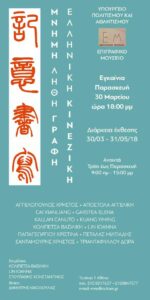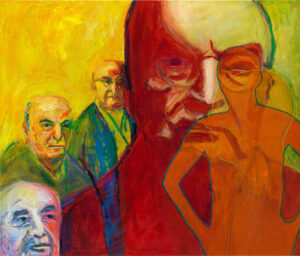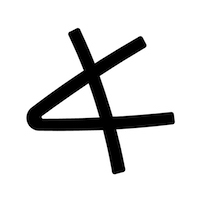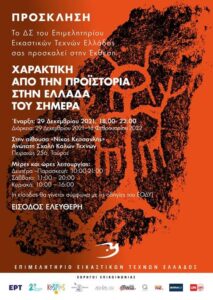
Big historical exhibition
“ENGRAVING – From Prehistory, to Greece Today”,
organizes the CHAMBER OF FINE ARTS OF GREECE (Ε.Ε.Τ.Ε.)
“Nikos Kessanlis” Hall,
School of Fine Arts,
Piraeus 256, Tavros
December 29, 2021-18 February 2022
free entrance
In the Autumn of 2017, the Engraving Office of EETE and ten engravers from its department, with the support of the Board, rushed by our two major successful exhibitions for the “Resistance 1936-1974”, we formed a big team and started working on a new exhibition, on a big idea. The idea that passes in front of us every day, through the toil of our work. And it is this small humble engraved line on wood, copper, stone, but also other materials, that becomes an engraving work, printed in many copies. And once upon a time, many thousands of years ago, man first carved it on a rock. To leave any imprint and communicate with fellow human beings. This small engraved line is the beginning of the spread of Knowledge throughout the Universe, it takes shape, it becomes a symbol, a letter, a writing. It is printed, it is printed, it is a book. It multiplies, it spreads everywhere. And the world acquires the great advantage of knowledge. So the beginning of the spread of knowledge and the beginning of the art of engraving was the idea and the motivation to create this exhibition entitled: “Engraving – From Prehistory to Greece today” and thus highlight this achievement. Because it is the Knowledge that together with Art, hand in hand, unites the People, the Peoples and the Yesterday with the Today. The exhibition is developed in the space chronologically in order to understand the course of writing, knowledge and engraving art. It starts with the Prehistoric Rock Engravings from China, France and Greece. It continues in the Ancient Historical Times with the symbols, seals, inscriptions, seal stones from Archaeological and Historical Museums of Greece and Cyprus. It thrives in China with ancient writings and historical engraving prints from Chinese museums. Continued in European Engraving of the Middle Ages, Renaissance, Impressionism and Japanese Art (from Collections). Proceeds to Lithographs of foreign travelers in Greece from Greek historical museums, and to Copper Icons of Icons of St. Terms. This course ends with engravings by Engravers of our place, members of Ε.Ε.Τ.Ε. On the one hand (from Collections) with the works of Engravers that are no longer alive and that many of them demonstrated with their Engravings important events and struggles of the modern History of our place, and on the other hand with the Engraving works of modern Engravers some of the which demonstrate the technical development of digital engraving in Greece.
Exhibits will be presented by:
The Ephorate of Antiquities of Paleoanthropology – Speleology, The Hetao Museum (China), The Archive of the Ministry of Culture of France, The National Archaeological Museum, The Epigraphic Museum, The Museum of the Ancient Agora, The Archaeological Museum of Thebes, The Time Museum of Larissa, The Archaeological Museum Of Messinia, The Archaeological Museum of Ioannina, The Museum of Science and Technology of China (Beijing), The Cyprus Museum, The Museum of Shanghai (China), The Museum-Library of Stratis Eleftheriadis / Teriand, The National Historical Museum – Athens Old Palace Museum Of Islamic Art – Benaki Museum, The Maritime Museum of Greece, The National Gallery – Museum of Alexandros Soutsos, The Museum of Asian Art of Corfu, Mount Athos.
Works through the historical course of the art of Engraving in the 20th century in Greece will be presented, by:
Alevizou Tassou, Asteriadis Aginora, Varlamou Giorgis, Vassilios Spyros, Velissaridis Giorgos, Ventoura Nikolaou, Galani Dimitris, Giannoukaki Dimitris, Grammatopoulou Costa, Dagli Christou, Dimou Giorgis, Zavimarouz Vazimanou Zavimzanou V , Kindyni Anna, Kogevina Lykourgou, Komianou Arias, Korogiannaki Alexandrou, Maggiorou Loukias, Makri Zizis, Montesantou Louizas, Morali Gianni, Moschou Giorgou, Bekiari Koulas, Nikolaidi Eulapas Polamis, Poulamos Polias Aristides, Semertzidis Valia, Stefanidis Giannis, Farsakidis George, Ferbou I Nikolaou, Harou Vassilis.
Also participating after an open invitation 143 Contemporary engravers-members of EETE with 223 projects:
Vasitskova Katarina, Angelopoulos Christos, Anagnostatou Elessa, Androutsakis Stathis, Annitsakis Odysseas, Anousi-Ilia Rena, Apostola Angeliki, Arvanitis Zacharias, Arfaras Michail, Achimastou Fankou, Varthis Garathis Varakas Matina, Georgoudakis Christos, Giannadakis Manolis, Galdemis Christodoulos, Garavela Vassiliki, Garstea Elena, Gioura Sultana, Golanda Nella, Goulakos Periklis, Gourzis Giannis, Delfino Ioankas, Dima Ioankas, Dasos Kalliopi), Kallan Canuto, Kampanis Markos, Kaprou Eleni, Karousi Panagiota (Betty), Keramea Zoi, Kolios Ioannis, Kolipetsa Vassiliki, Kompatsiari Maria, Koritsoglou Martha, Koukoulaki Ktilitora, Stella ) Kleves, Kritsotaki Aristea, Kyriakidis Giannis, Kyritsis Nikolaos, Konstantakou Anastasia, Kotsi Andriana, Kotsiou Konstantina, Lampretsa Dimitra, Lianos Athanasios, Liougas Evangelos, Manou Efi, Markaki Tzeni, Matala Maria, Matzari Despina, Mavrodoglou Valentini, Macharidi Efstratia, Mela Eva, Milexa Staoukaris, Milios Georgiou Mikili, Mili, Barounis Sotiris, Benaki Politimi Maria, Bozko Oksana, Boboli Sophia, Botsoglou Chronis, Niolis Gregory, Datsouli Vana, Xenakis Marianna, Xyla Xanalatou Iris, Xyneli Chrysoula, Economidou Florence Pagonis Alexander Pantelias Miltos, Pantolfini Pino, Papayannis Evangelos, Papadimitriou Vivian, Papadimitriou Maria, Papadopetrakis Euripides, Papadopoulou Natalia, Papadopoulou Sophia, Papaioannou Liana, Papaioannou Manto, Papanikolaou Eleni, Papanikolopoulou Nestor, Papafraga Sunday, Patsi Mary, Patsoglou Aristides, Peza Psara Eugenia, Petalas Miltiades, Petropoulou-Dimitrakis Mimi, Provatidis Marina, Rokos Stefanos, Saiti Chara, Sakellari Eleni-Sofia, Samatas Spyros, Sarelakou Rokou Rubini, Sachinis Xenis, Simitis Mouzakitis Fani- Ioanna, Siamkouri Magda, Siaterli Dimitra, Siniosoglou Amaryllis, Skyrgianni Eri-Georgia, Souliotou Anastasia Zoi, Sperantzas Vassiliki, Spiritas Vassilis, Spi , Sfyris Athanasios, Schoina Mary, Sotirchos Efstathios, Tzolaki Rena, Tuzloukof Vanessa -Ioanna, Tsalamata Vicky, Tselios Pantazis, Tserkezi Thalia, Tsoumani Angelina, Yantantiou Veneris, Yafantidou Venenis , Frangou-Nidrioti Eleni, Hande Maria, Charalambous Elsa (Elissavet), Harokopou Anastasia, Chatziioannou Stamatia, Chiotis Antonis, Christopoulos Ioannis, Christofylakis Stelios, Psychopedis Giannis

The art gallery “Adamantia”, in Nimporio of Andros, Greece presents the group engraving exhibition “O SYNOIKISMOS”.
The Settlement of Nimporio was created after the Asia Minor Catastrophe within walking distance from the metropolitan capital, Chora. In a place almost virgin around its factory, which initially operated as a silk factory and was after its final closure the first home of refugees.
Their arrival marked a new era for the wider region. By producing products unknown to the locals such as yogurt that they carried in suitcases in the mountain villages, ice cream, şambali. With the creation of organized grocery stores in Chora, the import of even coffee grinders from abroad, and the installation of showers in the nearby Gialia.
The post-war immigration of the majority of them to America and the catastrophic cementing of their homes since the 1970s permanently altered its character. The refugees, however, had managed to inoculate the local population.
Six artists try with the techniques and means of engraving art to give us its imprint and to travel us back in time. To show all this forgotten richness of intercultural communication.
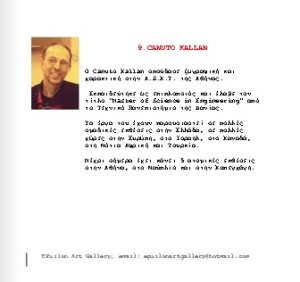 Online e-catalogue fom the exhibition “Art in Ou Hearts”
Online e-catalogue fom the exhibition “Art in Ou Hearts”
 The kallan.gr site was updated in a new design by Konstantinos Christodoulakis.
The kallan.gr site was updated in a new design by Konstantinos Christodoulakis.
It’s now working on all the platforms ANDROID and iOS as well.
The kallan.gr site was updated in a new design by Konstantinos Christodoulakis.
It’s now working on all the platforms ANDROID and iOS as well.The kallan.gr site was updated in a new design by Konstantinos Christodoulakis.
It’s now working on all the platforms ANDROID and iOS as well.The kallan.gr site was updated in a new design by Konstantinos Christodoulakis.
It’s now working on all the platforms ANDROID and iOS as well.
The kallan.gr site was updated in a new design by Konstantinos Christodoulakis.
It’s now working on all the platforms ANDROID and iOS as well.
The kallan.gr site was updated in a new design by Konstantinos Christodoulakis.
It’s now working on all the platforms ANDROID and iOS as well.

“In Memory of George Bouzianis”, EPsilon Art Gallery, Loutraki, Greece. Curator Christos Theofilis
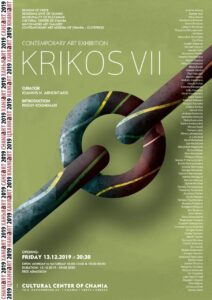
Krikos VII, Cultural Center of Chania, curator: Ioannis N. Arhontakis
https://m.facebook.com/101740738258953/photos/a.101769231589437/126323962467297/?type=3&source=54
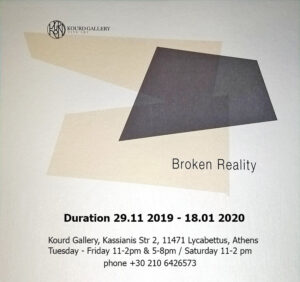
“Broken Reality”, Kourd Gallery, Athens, Greece. Curator Lida Kazantzaki.
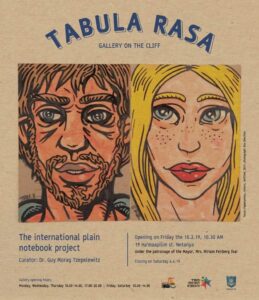
The International plain Notebook Project, curator Dr Guy Moraq, Gallery on the Cliff, Netanya, Israel

“Journey – from the Personal to the Collective”
The first exhibition of the artgroup Ana
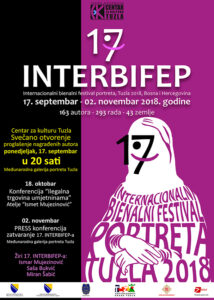
17.09.2018 International Biennial Festival of Portrait, Drawings and Graphics 2018 ( XVII INTERBIFEP ), Tuzla, Bosnia and Herzegovina
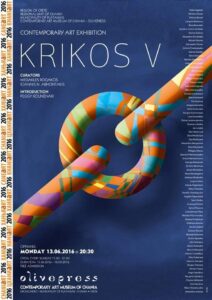
Krikos V, Olivepress, Contemporary Art Museum of Chania, curator: Ioannis N. Arhontakis and Megakles Rogakos
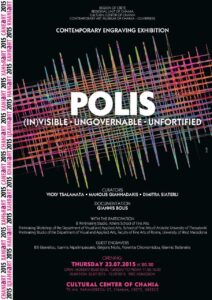 “Polis, (In)Visible-Ungovernable-Unfortified”,CHANIaRT, Cultural Center of Chania, Crete. Curators: Manolis Giannadakis, Dimitra Siaterli and Vicky Tsalamata
“Polis, (In)Visible-Ungovernable-Unfortified”,CHANIaRT, Cultural Center of Chania, Crete. Curators: Manolis Giannadakis, Dimitra Siaterli and Vicky Tsalamata
“Polis, (In)Visible-Ungovernable-Unfortified”,CHANIaRT, Cultural Center of Chania, Crete. Curators: Manolis Giannadakis, Dimitra Siaterli and Vicky Tsalamata“Polis, (In)Visible-Ungovernable-Unfortified”,CHANIaRT, Cultural Center of Chania, Crete. Curators: Manolis Giannadakis, Dimitra Siaterli and Vicky Tsalamata“Polis, (In)Visible-Ungovernable-Unfortified”,CHANIaRT, Cultural Center of Chania, Crete. Curators: Manolis Giannadakis, Dimitra Siaterli and Vicky Tsalamata“Polis, (In)Visible-Ungovernable-Unfortified”,CHANIaRT, Cultural Center of Chania, Crete. Curators: Manolis Giannadakis, Dimitra Siaterli and Vicky Tsalamata“Polis, (In)Visible-Ungovernable-Unfortified”,CHANIaRT, Cultural Center of Chania, Crete. Curators: Manolis Giannadakis, Dimitra Siaterli and Vicky Tsalamata
https://m.facebook.com/101740738258953/photos/a.101769231589437/126323962467297/?type=3&source=54
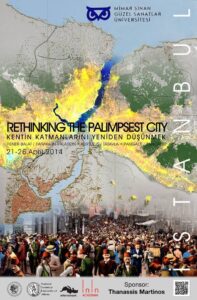 Symposium Rethinking the Palimpsest City, Istanbul 21-26 April 2014.
Symposium Rethinking the Palimpsest City, Istanbul 21-26 April 2014.
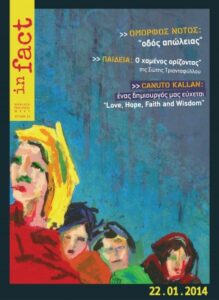
Interview with Canuto Kallan in the magazine “IN FACT” no 21 ISSN:2241-3073
http://issuu.com/georgexeil/docs/infact_21
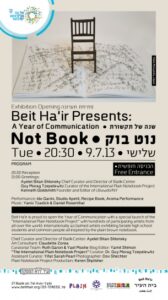
“Together with Kenneth Goldsmith\’s work, the exhibition Not Book will take place at the Beit Ha’ir Urban Culture Museum in Tel Aviv the “”International Plain Notebook Project””, curated by Dr. Guy Morag Tzepelewitz, dedicated to the plain brown notebook. This notebook, associated with the educational system of the early days of socialistic Zionism in Eretz Israel, is a political object of sorts, which like the ideology, faces extinction. The notebook becomes an international creative platform, inviting subconscious connection to free and liberated creation. The brown notebook – which we are familiar with from our first years in school is radically transformed when removed from the ideological Israeli context and put into our current times, in which values of internationalism and individualism are cherished. The project proposes a fresh model for collective, interdisciplinary and universal art, which brings together hundreds of artists from different backgrounds, abolishing the customary hierarchies defined by the art establishment.
Over 350 artists from 45 different countries participate in this wide-scope project, contributing unique pieces in a variety of techniques: two-dimensional, sculptures and 3D, video works and spatial installations. Some of the prominent artists participating in the exhibition are Mark Ulriksen from San Francisco, well-known as the official New Yorker illustrator since 1993; Roger Ballen, an American photographer who mainly photographs residents of rural villages in South Africa, and who has exhibited at the Pompidou Center, the Victoria and Albert Museum and the MoMA; Steingrimur Eyfjord from Iceland, who has participated in the Venice Biennale in 2007; and Nalini Malani from India, a well-known artist whose works are influenced by her experiences as a refugee in India. Some of the prominent Israeli artists are: David Tratakover, Anisa Askar, Doron Rabina, Daniel Landau, Yair Garbuz, Keren Shpilsher, Dina Shenhav, Itzik Rennert, new video works by Shahar Marcus and Ariella Plotkin as well as students from Thelma Yellin and Gymnasia Herzliya including Roei Palant, Maya Pollak and Shanee Roe from the 10th grade, who created a spectacular booklet out of her math notebook from her summer course for students who failed.
“In a digital world, where economic and political forces coerce us to continuously be swept away in the technological whirlwind,”” Says Ayelet Bitan Shlonsky, Chief Curator and Director of the Bialik Complex, “”this exhibition raises questions currently at the center of the art, cultural and social discussion: what is the balance of powers at present between the new and the old media, and where is this heading? What is original creation in the digital era? What is the role of the museum and the curator in an age where hierarchies have blurred, and information is free and available to all?”
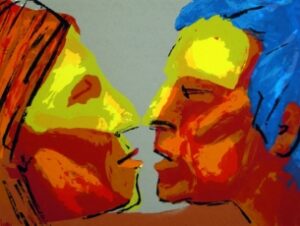
Stratis Tsirkas “Drifting cities”.
A contemporary printmaking exhibition. The works will draw on the famous trilogy “Drifting cities” by Greek writer Stratis Tsirkas (1911-1980).
From 16.11.11 until 17.12.11
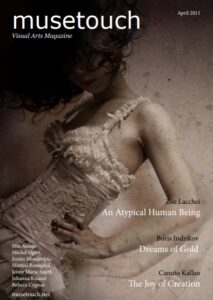
Interview with Canuto Kallan in the magazine “Musetouch” no 9 by Maia Sylba April 2011
https://musetouch.org/canuto-kallan-the-joy-of-creation/
https://musetouch.org/issue-9/
Canuto Kallan
Canuto Kallan was born in 1960 in Copenhagen, Denmark. Before studying at the Athens School of Fine Arts, he graduated in 1989 from the Technical College of Copenhagen as a cabinet-maker and was awarded the Silver Medal for Woodworking by the Queen of Denmark. At the same time he was studying at the Technical University of Denmark, from where he graduated in 1990 as a Mechanical Engineer (Master of Science ίn Engineering). In 2003 he graduated with distinction from the Athens School of Fine Arts, where he studied painting and later on printmaking.
During the 2010 FIFA World Cup in South Africa he was invited to represent Denmark as one of the five Danish artists in the “2010 Fine Art” world art event and exhibition.
Canuto Kallan and the Danish musician Morten Carlsen (member of the famous jazz and world music orchestra, “The New Jungle Orchestra”) started an interdisciplinary cooperation transforming images to music and vice versa in November 2010.
Until today he has presented his work in 4 solo shows in Denmark and Greece and has participated in numerous group shows.He is a member of the Greek Chamber of Fine Arts and the Danish Association of Visual Artists. Since 1993 he lives and works in Athens.
The works of Canuto Kallan can be found in collections such as:
The Collection of Papadrielleiou Gallery in Komotini Greece, the Greek head office of Burmeister & Wain – ΜΑΝ, Piraeus, the Hotel Creta Maris, Crete, the Hotel Knossos Beach,
Crete, the head office of Postscriptum, Athens, and private collections.
When did you first realize you are an artist?
Art has always played a big role in my life. As a child I was into both music and painting. I was 10 when I won my first prize for one of my paintings. Regarding music I started with the recorder, I continued with violin and viola and ended up on the saxophone. At university, when I studied engineering, I could not practice so freely on my saxophone because I was living in a dormitory, so I turned into painting in order to be able to satisfy my inner need for self – expression. I started covering the walls of my room with drawings and colours. Later on,
during a trip to Tuscany, I met an icon painter who asked me to become his pupil. Unfortunately, he died a few months before I could complete my studies and then be taught by him. He kindly bequeathed me all of his icons so that I could study and be inspired by them. In
the meantime I received the First Prize for the piece of furniture that I had created for my cabinetry thesis in Denmark. The scholarship I received made it possible for me to come to Greece. There I resumed my study of icon painting which then led me to the Athens School of Fine Arts. So I guess it was more a process of my inner needs than a sudden realization that led me to become a painter.
Can you tell me more about yourself and your art?
The colours in my paintings are probably what characterize my work, and is for a big part the reason for me to paint. I presume this influence comes from my childhood in Denmark, where the nature is grey for 6 months of the year. In the winter it is very dark and often foggy. When it snows it is beautiful and bright, but then the only colour is the blue of the sky. That time of the year was a nightmare for me, while spring, when nature is bursting forth with flowers of all colours and green leaves on the trees, was my rebirth! I live in Athens, which is a crowded place. So my paintings are mainly about people and the relations among them. But when I occasionally paint outside Athens I use the nature as a source of inspiration. Actually my palette became much clearer and stronger following a trip to a Greek island in springtime. The colours in the Greek nature are usually very dull and dusty most of the year, except during the spring.
What inspires you to create art and how do you keep motivated yourself?
I usually start out from something I “see” that moves my sensations. It may be something I see during day to day life or a photo, a thought or simply a colour and then, based on my feelings, I then proceed. Before I start a painting, I may have a clear idea about what I would do, but usually only for a start and then I follow a path on the canvas. However, I am not in a position to define what leads me during this process. Often it feels like a struggle with myself and the colours. The canvas becomes my battlefield. Many think that an artist waits for the inspiration to come on him, but that is not the way it works, at least for me and most of my colleagues I know off. Inspiration comes by working. One idea gives room to more ideas to come in.
Is the subject important to you, or do you simply paint to express yourself?
It is a combination of both. The subject may be the reason to start out but the actual process of painting leads me to satisfaction. At a certain point I don’t think of the subject anymore but only what happens on the canvas in terms of forms, colours, harmonies etc.
Your paintings have a lot of strong emotions in them, are they yours or the subjects emotions?
I try to be honest with my emotions, so it is my emotions that guide me in the creation, and not so much emotions I try to put into my subjects. In the end I guess it’s a combination of mine and the spectator’s emotions that the spectator feels in front of the final picture. It is the same about what we see in a picture. What we understand and see is according to our personal experiences. We don’t always comprehend or interpreter images the same way.
What artists have influenced you, and how?
I could mention two experiences that influenced me intensively; the first was a retrospective exhibition of Emil Nolde’s works and, the second, my visit to the Edvard Munch Museum during a trip to Norway. I believe these two artists was an inspiration to me for wanting to paint much more.
I have also been influenced by Marc Chagall and not to forget the Co.Br.A movement to mention a few more. But actually the list is very long. The influence is not always very clear or conscious. Once something has moved us it stays inside us and may come out when we least expect it.
What’s the best and worst part of being an artist?
The best part is very obvious; you do something you love and cannot live without doing it. To create is a very basic human function that gives satisfaction and pleasure. So in this sense I am very fortunate. The worst part of being an artist are really many and of various substances. Beside the economic problems most artists are facing, I believe the worst part is that the artists’ role is being ignored and especially in times of crisis, like this we are going through now. Art is being regarded as luxury and not something that can bring new ideas and inspiration for creating new ways of facing life and its problems. Big sums are so easily spend on destruction, weapons and wars and so difficult so small amounts are spend on art, that can create much better environments, give new experiences, bring people together etc.
Could you talk about your latest series of paintings and what you are trying to achieve with them?
In March 2011 I had my latest show in Athens called “Greener on the Other Side”. It includes paintings that aim at the exploration of the inner and outer world and the projection of the emotional perception of human existence. The title of the exhibition, which is a Danish saying, implies the tendency we have to believe that the “opposite side of the shore”, the “other” reality which we do not experience, is a better, “greener” place – like another “Promised Land”, an unknown world that we idealize. During hard times, this illusion becomes often a conviction and an obsession that obstructs us from paying attention to, and living in, the “here and now”, and from finding our way out through the difficulties in a creative manner. It is a state of mind we all now and then is going through. For the time being it is very apropos in my Greek circles.
If you are about to paint your last painting ever…what and how it would be?
I know what you mean, but actually every painting is my last painting in the very moment I create them. The way I work, as I mentioned before, makes it absurd for me to talk about a planned final painting.
How do you see yourself in the future…do you like to make plans or just letting it be?
In life we need both dreams and plans. If we want to achieve something we have to work according to a plan, and not just fly with the wind. It is like sailing on the ocean, you don’t just leave the sails and the wind to decide, but trim the sails and set a course. Anything else will only just provoke disaster.
I hope I’ll be able to continue painting, and through my art be able to break down some of the walls that separate people. I come from a family with various origins: fishermen in North Scandinavia, farmers and shoe makers in Denmark, ballerinas in Berlin, pharmacists in Istanbul. As a child I met at home people from different parts of the world, from other continents, Africans, Asians, Latin Americans. That is why I distance myself from those who consider themselves superior due to their colour, nationality, religion, vocation or gender, since, from an early age, I discovered that all humans basically seek and feel the same things. My painted “Walls” for an example are for peace, unity, open discussions, mutual respect to mention a few things and not separation, suppression, fanaticism etc.
MS

“Greener On the Other Side”
Duration: 15/3 – 2/4/2011
Opening: 15/3/2011
Canuto Kallan’s solo exhibition at Gallery Kaplanon 5 entitled “Greener On the Other Side” includes paintings that aim at the exploration of the inner and outer world and the projection of the emotional perception of human existence. The title of the exhibition, which is a Danish saying, implies the tendency we have to believe that the “opposite side of the shore”, the “other” reality which we do not experience, is a better, “greener” place – like another “Promised Land”, an unknown world that we idealise. During hard times, this illusion becomes often a conviction and an obsession that obstructs us from paying attention to, and living in, the “here and now”, and from finding our way out through the difficulties in a creative manner. Through the distortion of the figure, the impulse inherent in his expressive idiom, the dynamism of the colour with its motion and rhythm that emotionally activates the viewer, Canuto Kallan expresses his inner agony for the current era. Inwardness and explosion of colour, instinct and the exact choice of elements of his compositions, unconscious and aesthetical criteria coexist and act synergistically, initially as a reaction to one another and then united in harmony. In Kallan\’s works the energy born and “exhausted” between the humans and the interaction of the people in his multi-figured compositions create “psychological snapshots” that narrate the way in which emotions, fears and dreams are being shaped. At the opening of the exhibition the Danish musician Morten Carlsen, a member of the famous jazz and world music band “New Jungle Orchestra” will “translate” Canuto Kallan’s works into music, improvising on his saxophone in a live performance. The audio-visual material of the collaboration between the two artists will be presented during the entire duration of the exhibition.

2010 International Fine Art
The first-ever FIFA World Cup™ to be hosted on African soil will focus the world’s attention on the continent with greater intensity than at any other time in modern history. This concentration of positive energy and Afro-enthusiasm provides the ideal artistic context for leading contemporary artists from around the world to create works inspired by the 2010 FIFA World Cup South Africa™ – the result is the 2010 International Fine Art Collection.
Five leading contemporary artists are being invited from each of the 32 countries that will qualify for the 2010 FIFA World Cup South Africa™ to participate in this project. Each artist is being invited to interpret the same theme, drawing inspiration from Africa, the FIFA World Cup™, and their country’s own national pride, in the style of their choice.
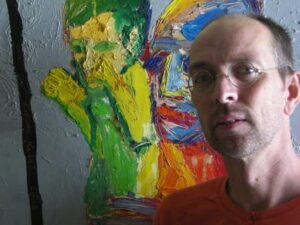
Canuto Kallan – Into the unconscious depths of human existence
by Maia Sylba September 5 2010
https://musetouch.org/canuto-kallan-into-the-unconscious-depths-of-human-existence/
Canuto Kallan – Into the unconscious depths of human existence
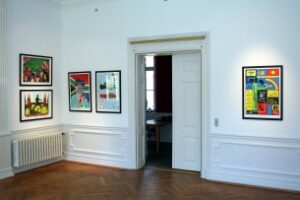
2010 International Fine Art at Augustiana, Denmark
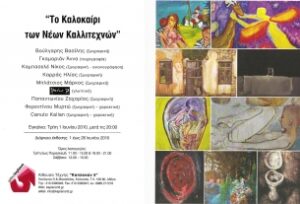
Group show Gallery Kaplanon 5, Athens, Greece

Selected artworks of the “2010 Fine Art” is exhibited in the Gallery Galerie in Berlin,
Karl-Marx-Allee 76, 10243 Berlin, Germany
28/5-31/7 2010
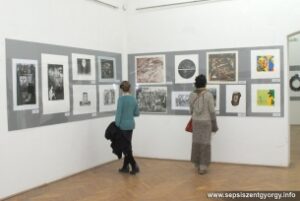
Photo from the exhibition.
More on:
http://www.sepsiszentgyorgy.info/rendezvenyek/74-gyarfas-jen-keptar/425-i-szekelyfoeldi-grafikai-biennale
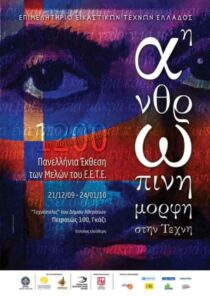
The Human Form in Art.
21 December 2009- 24 January 2010
A retrospective of 1200 visual artists, members of the Greek Chamber of Fine Arts (EETE).
CINEPHILE-14 young artists go to cinema.
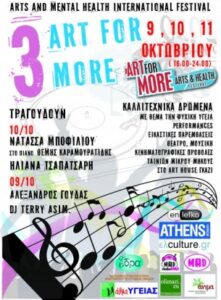
During the 3nd International festival “Art for more” Canuto Kallan was rewarded for the best painting.
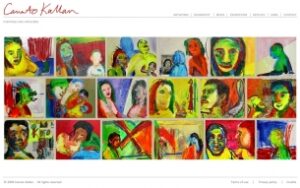
The kallan.gr site was updated in a new design. The colors of Canuto‘s work are now more bright on a white minimal background.
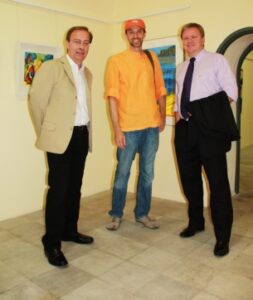
Janis Vakarelis, artistic director, Canuto Kallan and Tom Nørring, ambassador of Denmark.
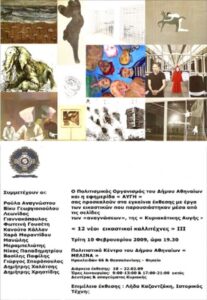
“12 young artists” III
Curator Lida Kazantzaki, art historian.
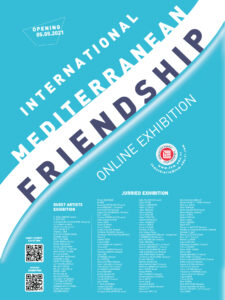 Online exhibition:
Online exhibition: